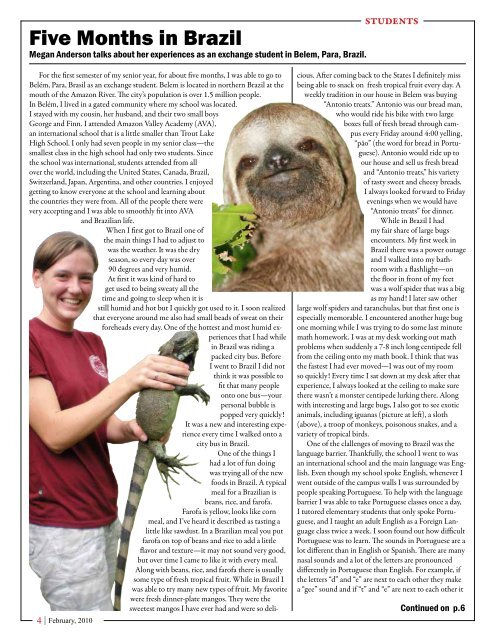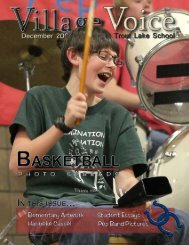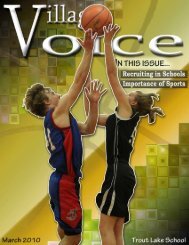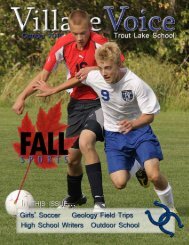February 2010 - Trout Lake School
February 2010 - Trout Lake School
February 2010 - Trout Lake School
- No tags were found...
You also want an ePaper? Increase the reach of your titles
YUMPU automatically turns print PDFs into web optimized ePapers that Google loves.
Five Months in Brazil<br />
Megan Anderson talks about her experiences as an exchange student in Belem, Para, Brazil.<br />
STUDENTS<br />
For the first semester of my senior year, for about five months, I was able to go to<br />
Belém, Para, Brasil as an exchange student. Belem is located in northern Brazil at the<br />
mouth of the Amazon River. The city’s population is over 1.5 million people.<br />
In Belém, I lived in a gated community where my school was located.<br />
I stayed with my cousin, her husband, and their two small boys<br />
George and Finn. I attended Amazon Valley Academy (AVA),<br />
an international school that is a little smaller than <strong>Trout</strong> <strong>Lake</strong><br />
High <strong>School</strong>. I only had seven people in my senior class—the<br />
smallest class in the high school had only two students. Since<br />
the school was international, students attended from all<br />
over the world, including the United States, Canada, Brazil,<br />
Switzerland, Japan, Argentina, and other countries. I enjoyed<br />
getting to know everyone at the school and learning about<br />
the countries they were from. All of the people there were<br />
very accepting and I was able to smoothly fit into AVA<br />
and Brazilian life.<br />
When I first got to Brazil one of<br />
the main things I had to adjust to<br />
was the weather. It was the dry<br />
season, so every day was over<br />
90 degrees and very humid.<br />
At first it was kind of hard to<br />
get used to being sweaty all the<br />
time and going to sleep when it is<br />
still humid and hot but I quickly got used to it. I soon realized<br />
that everyone around me also had small beads of sweat on their<br />
foreheads every day. One of the hottest and most humid experiences<br />
that I had while<br />
in Brazil was riding a<br />
packed city bus. Before<br />
I went to Brazil I did not<br />
think it was possible to<br />
fit that many people<br />
onto one bus—your<br />
personal bubble is<br />
popped very quickly!<br />
It was a new and interesting experience<br />
every time I walked onto a<br />
city bus in Brazil.<br />
One of the things I<br />
had a lot of fun doing<br />
was trying all of the new<br />
foods in Brazil. A typical<br />
meal for a Brazilian is<br />
beans, rice, and farofa.<br />
Farofa is yellow, looks like corn<br />
meal, and I’ve heard it described as tasting a<br />
little like sawdust. In a Brazilian meal you put<br />
farofa on top of beans and rice to add a little<br />
flavor and texture—it may not sound very good,<br />
but over time I came to like it with every meal.<br />
Along with beans, rice, and farofa there is usually<br />
some type of fresh tropical fruit. While in Brazil I<br />
was able to try many new types of fruit. My favorite<br />
were fresh dinner-plate mangos. They were the<br />
sweetest mangos I have ever had and were so deli-<br />
4 | <strong>February</strong>, <strong>2010</strong><br />
cious. After coming back to the States I definitely miss<br />
being able to snack on fresh tropical fruit every day. A<br />
weekly tradition in our house in Belem was buying<br />
“Antonio treats.” Antonio was our bread man,<br />
who would ride his bike with two large<br />
boxes full of fresh bread through campus<br />
every Friday around 4:00 yelling,<br />
“pão” (the word for bread in Portuguese).<br />
Antonio would ride up to<br />
our house and sell us fresh bread<br />
and “Antonio treats,” his variety<br />
of tasty sweet and cheesy breads.<br />
I always looked forward to Friday<br />
evenings when we would have<br />
“Antonio treats” for dinner.<br />
While in Brazil I had<br />
my fair share of large bugs<br />
encounters. My first week in<br />
Brazil there was a power outage<br />
and I walked into my bathroom<br />
with a flashlight—on<br />
the floor in front of my feet<br />
was a wolf spider that was a big<br />
as my hand! I later saw other<br />
large wolf spiders and taranchulas, but that first one is<br />
especially memorable. I encountered another huge bug<br />
one morning while I was trying to do some last minute<br />
math homework. I was at my desk working out math<br />
problems when suddenly a 7-8 inch long centipede fell<br />
from the ceiling onto my math book. I think that was<br />
the fastest I had ever moved—I was out of my room<br />
so quickly! Every time I sat down at my desk after that<br />
experience, I always looked at the ceiling to make sure<br />
there wasn’t a monster centipede lurking there. Along<br />
with interesting and large bugs, I also got to see exotic<br />
animals, including iguanas (picture at left), a sloth<br />
(above), a troop of monkeys, poisonous snakes, and a<br />
variety of tropical birds.<br />
One of the clallenges of moving to Brazil was the<br />
language barrier. Thankfully, the school I went to was<br />
an international school and the main language was English.<br />
Even though my school spoke English, whenever I<br />
went outside of the campus walls I was surrounded by<br />
people speaking Portuguese. To help with the language<br />
barrier I was able to take Portuguese classes once a day,<br />
I tutored elementary students that only spoke Portuguese,<br />
and I taught an adult English as a Foreign Language<br />
class twice a week. I soon found out how difficult<br />
Portuguese was to learn. The sounds in Portuguese are a<br />
lot different than in English or Spanish. There are many<br />
nasal sounds and a lot of the letters are pronounced<br />
differently in Portuguese than English. For example, if<br />
the letters “d” and “e” are next to each other they make<br />
a “gee” sound and if “t” and “e” are next to each other it<br />
Continued on p.6






